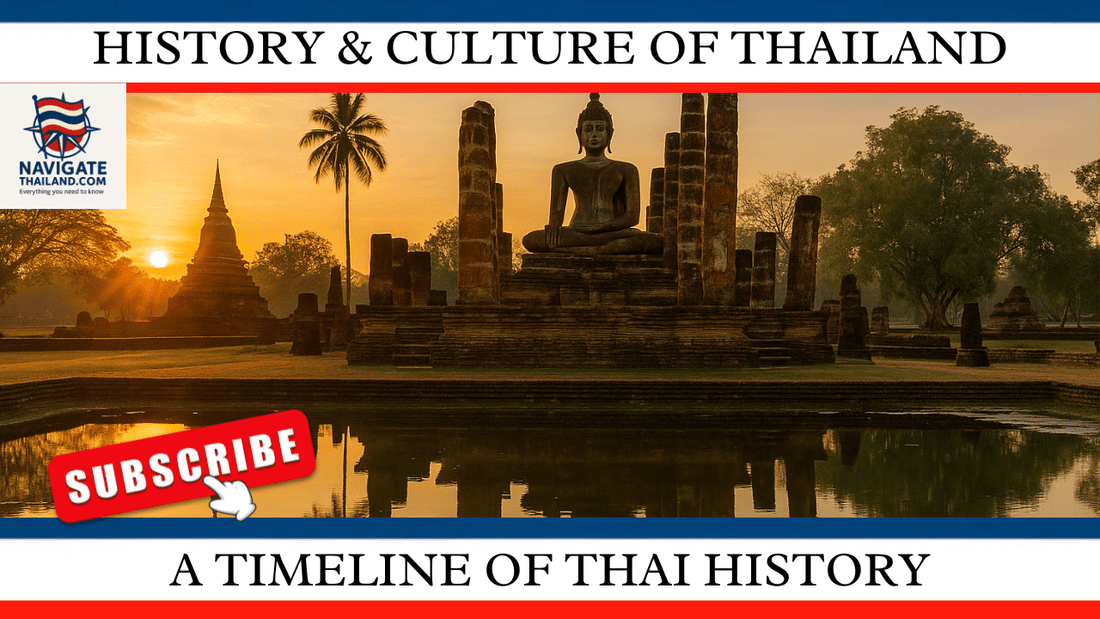
From Sukhothai to Siam: A Timeline of Thai History for Travellers
Share
Thailand isn’t just a country of beaches and curries — it’s a nation layered in centuries of culture, kingship, and resilience. For curious travellers, the story of Thailand isn’t just found in museums; it’s alive in crumbling ruins, ancient temples, and lively traditions.
From the spiritual beginnings of Sukhothai to the mighty Ayutthaya, and the dramatic shift into Siam, this blog gives you a traveller-friendly timeline of Thai history and exactly where to experience it. If you’re visiting Thailand in 2025 and want a deeper cultural connection, read on.
🛕 Fun Fact: Thailand is the only Southeast Asian country never colonised by a European power.
🏯 The Sukhothai Kingdom (1238–1438) — The Dawn of Thai Identity
Where to Experience It:
Sukhothai Historical Park, Northern Thailand
Often called the cradle of Thai civilisation, Sukhothai marked the birth of the Thai script and Theravāda Buddhism’s widespread adoption.
This era championed a golden rule by King Ramkhamhaeng, who introduced fairness, meritocracy, and that iconic Thai style of smiling diplomacy.
📜 Ramkhamhaeng’s Stone Inscription is recognised by UNESCO as one of the earliest records of the Thai alphabet.
Don’t Miss:
- Ride a bicycle through Sukhothai Historical Park, a tranquil UNESCO site dotted with lotus ponds and sandstone Buddhas.
- Climb Wat Sa Si for sunset views.
🏰 The Ayutthaya Kingdom (1350–1767) — Thailand’s Golden Age
Where to Experience It:
Ayutthaya, just 1 hour from Bangkok
Once one of the world’s largest and most cosmopolitan cities, Ayutthaya was a centre of diplomacy, trade, and art. Merchants from Persia, Portugal, Japan, and France all had enclaves here.
The kingdom’s capital was razed by Burmese forces in 1767 — but its ghostly ruins still tell tales of grandeur.
🏺 Fun Fact: Ayutthaya’s hydraulic engineering was so advanced, it prevented seasonal flooding for centuries.
Must-See Sites:
- Wat Mahathat, home to the famous Buddha head entwined in tree roots
- Wat Phra Si Sanphet, once part of the royal palace
- Evening boat tour around the city island
⚔️ The Thonburi Period (1767–1782) — The Bridge Kingdom
Where to Experience It:
Thonburi District, Bangkok
After Ayutthaya’s fall, General Taksin established a short-lived but critical capital across the river in Thonburi. Though brief, it was a pivotal rebuilding period for Siam.
⚓ Fun Fact: King Taksin is one of the few Thai rulers who wasn’t of noble blood — he was of Chinese-Thai descent.
Historical Highlights:
- Visit Wat Arun (Temple of Dawn), built during Thonburi’s reign
- Take a longtail boat through the Thonburi canals to see Bangkok’s “Venice of the East” roots
👑 The Rattanakosin Era & The Rise of Siam (1782–1932)
Where to Experience It:
Bangkok – Grand Palace, Dusit, and Rattanakosin Island
Founded by King Rama I, this era saw the modernisation of Siam and Bangkok’s transformation into a world-class city.
🧠 Fun Fact: “Siam” was Thailand’s official name until 1939 — and briefly again from 1945 to 1949.
Cultural Hotspots:
- The Grand Palace – still used for royal ceremonies today
- Wat Phra Kaew (Emerald Buddha Temple) – Thailand’s most sacred site
- Dusit Palace – a symbol of early 20th-century Western influence
📜 Thailand’s Transition to Democracy (1932–Today)
Thailand’s 1932 revolution transitioned it from absolute monarchy to a constitutional one. Since then, it’s undergone coups, reforms, economic booms, and waves of cultural revival.
The term “Land of Smiles” was born out of this modern identity: resilient, gracious, and future-facing.
Modern History Museums to Explore:
- Museum Siam – Fun, interactive exhibits about Thai identity
- Rattanakosin Exhibition Hall – Great for first-time visitors
- Bangkok National Museum – The largest of its kind in Southeast Asia
Map Your Journey Through Thai History
Here’s a sample cultural route to trace Thailand’s historical timeline:
|
Era |
Place to Visit |
Time from Bangkok |
|
Sukhothai |
Sukhothai Historical Park |
1 hr flight / 6 hr bus |
|
Ayutthaya |
Ayutthaya Ruins |
1 hr train |
|
Thonburi |
Wat Arun & Khlongs |
30 mins by ferry |
|
Rattanakosin |
Grand Palace, Bangkok |
City centre |
|
Modern Thailand |
Museums & Parliament |
City centre |
🎁 Want More Depth? Grab Our eBook!
If you’re captivated by Thailand’s past, don’t miss our full eBook:
📘 “The History and Culture of Thailand: A Journey Through Thailand from the Beginning to Today”
It’s your ultimate guide to:
- Thai dynasties and kings
- Language and script development
- Religion, war, politics, and trade
- How the past still shapes Thailand today
→ Available now on NavigateThailand.com/collections/ebooks
Perfect for pre-trip reading or while temple-hopping in Chiang Mai or Ayutthaya.
Final Thoughts: History for the Heart and the Feet
Travelling through Thai history is like watching a beautiful mural unfold across the land — painted in gold, smoke, lotus flowers, and royal decrees.
Whether you’re wandering Sukhothai’s ruins at dawn or bowing before Bangkok’s Emerald Buddha, you’re walking in the footsteps of monarchs, monks, and millions of ancestors.
Make your next trip not just a holiday, but a journey through time.
Ready to uncover the real Thailand?
👉 Download our eBook “The History and Culture of Thailand” and plan your cultural adventure with purpose.
Shop now on NavigateThailand.com and start exploring beyond the beaches.










































































































































